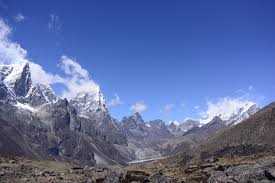
As the Earth warms at an alarming rate, few regions are feeling the pressure as intensely as Uttarakhand. Nestled in the lap of the Himalayas, this serene hill state—known for its spiritual heritage, glacial rivers, and rich biodiversity—is witnessing the brutal consequences of global warming up close.
Melting glaciers, deadly flash floods, vanishing springs, erratic weather, and rising migration are no longer isolated events—they are signs of a deep and ongoing climate crisis.
The 2021 Chamoli disaster, triggered by a sudden glacial burst, and the catastrophic 2013 Kedarnath floods are not one-off tragedies. They are harbingers of what lies ahead if urgent action is not taken.
Mountains Under Threat
The glaciers that feed the Ganga and Yamuna—lifelines for millions—are retreating year after year. The Gangotri Glacier, for instance, has receded over 2 kilometers in the last century. Smaller glaciers are disappearing even faster, leading to the formation of unstable glacial lakes that could burst at any time.
These melting ice reserves, once dependable, now cause flash floods in one season and water scarcity in the next. Villages that once relied on perennial springs now depend on water tankers.
The hills are also increasingly vulnerable to landslides, cloudbursts, and forest fires—all aggravated by rising temperatures, deforestation, and haphazard construction. The monsoon, once predictable, now brings both drought and devastation.
Lives and Livelihoods at Stake
The climate crisis in Uttarakhand is not just about nature—it is about people. Farmers face crop failures due to erratic rainfall. Indigenous millet varieties like mandua and jhangora are being abandoned. With agriculture becoming unsustainable, thousands of young people are migrating to cities in search of work, leaving behind “ghost villages” across the hill districts.
Tourism, the state’s economic backbone, is also under threat. Extreme weather, infrastructure damage, and safety concerns are reducing tourist confidence in once-thriving destinations like Kedarnath, Nainital, and Chopta. Meanwhile, the unchecked growth of roads, resorts, and hotels in fragile zones only worsens the ecological imbalance.
The cost is paid not only in lives and livelihoods but also in the health of the population. Heat stress, mental trauma from disasters, and emerging vector-borne diseases like dengue and malaria are on the rise—even in high-altitude zones that were once immune.
A Call for Resilience
The response so far has been piecemeal. While the Uttarakhand government has launched its State Action Plan on Climate Change, real progress requires more than policy—it needs enforcement, coordination, and vision.
Disaster-resilient infrastructure, climate-smart farming, eco-sensitive tourism, and water conservation must become central to development planning. Forests must be protected not just as carbon sinks, but as lifelines for local communities.
Most importantly, the voices of hill people—especially women, farmers, and youth—must guide policy. Local organizations like HESCO and CHIRAG are already showing the way by reviving springs, promoting traditional crops, and preparing villages for climate shocks. Scaling such efforts is not an option; it is a necessity.
Email:------------swatidumka620@gmail.com
As the Earth warms at an alarming rate, few regions are feeling the pressure as intensely as Uttarakhand. Nestled in the lap of the Himalayas, this serene hill state—known for its spiritual heritage, glacial rivers, and rich biodiversity—is witnessing the brutal consequences of global warming up close.
Melting glaciers, deadly flash floods, vanishing springs, erratic weather, and rising migration are no longer isolated events—they are signs of a deep and ongoing climate crisis.
The 2021 Chamoli disaster, triggered by a sudden glacial burst, and the catastrophic 2013 Kedarnath floods are not one-off tragedies. They are harbingers of what lies ahead if urgent action is not taken.
Mountains Under Threat
The glaciers that feed the Ganga and Yamuna—lifelines for millions—are retreating year after year. The Gangotri Glacier, for instance, has receded over 2 kilometers in the last century. Smaller glaciers are disappearing even faster, leading to the formation of unstable glacial lakes that could burst at any time.
These melting ice reserves, once dependable, now cause flash floods in one season and water scarcity in the next. Villages that once relied on perennial springs now depend on water tankers.
The hills are also increasingly vulnerable to landslides, cloudbursts, and forest fires—all aggravated by rising temperatures, deforestation, and haphazard construction. The monsoon, once predictable, now brings both drought and devastation.
Lives and Livelihoods at Stake
The climate crisis in Uttarakhand is not just about nature—it is about people. Farmers face crop failures due to erratic rainfall. Indigenous millet varieties like mandua and jhangora are being abandoned. With agriculture becoming unsustainable, thousands of young people are migrating to cities in search of work, leaving behind “ghost villages” across the hill districts.
Tourism, the state’s economic backbone, is also under threat. Extreme weather, infrastructure damage, and safety concerns are reducing tourist confidence in once-thriving destinations like Kedarnath, Nainital, and Chopta. Meanwhile, the unchecked growth of roads, resorts, and hotels in fragile zones only worsens the ecological imbalance.
The cost is paid not only in lives and livelihoods but also in the health of the population. Heat stress, mental trauma from disasters, and emerging vector-borne diseases like dengue and malaria are on the rise—even in high-altitude zones that were once immune.
A Call for Resilience
The response so far has been piecemeal. While the Uttarakhand government has launched its State Action Plan on Climate Change, real progress requires more than policy—it needs enforcement, coordination, and vision.
Disaster-resilient infrastructure, climate-smart farming, eco-sensitive tourism, and water conservation must become central to development planning. Forests must be protected not just as carbon sinks, but as lifelines for local communities.
Most importantly, the voices of hill people—especially women, farmers, and youth—must guide policy. Local organizations like HESCO and CHIRAG are already showing the way by reviving springs, promoting traditional crops, and preparing villages for climate shocks. Scaling such efforts is not an option; it is a necessity.
Email:------------swatidumka620@gmail.com
© Copyright 2023 brighterkashmir.com All Rights Reserved. Quantum Technologies